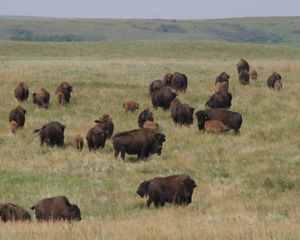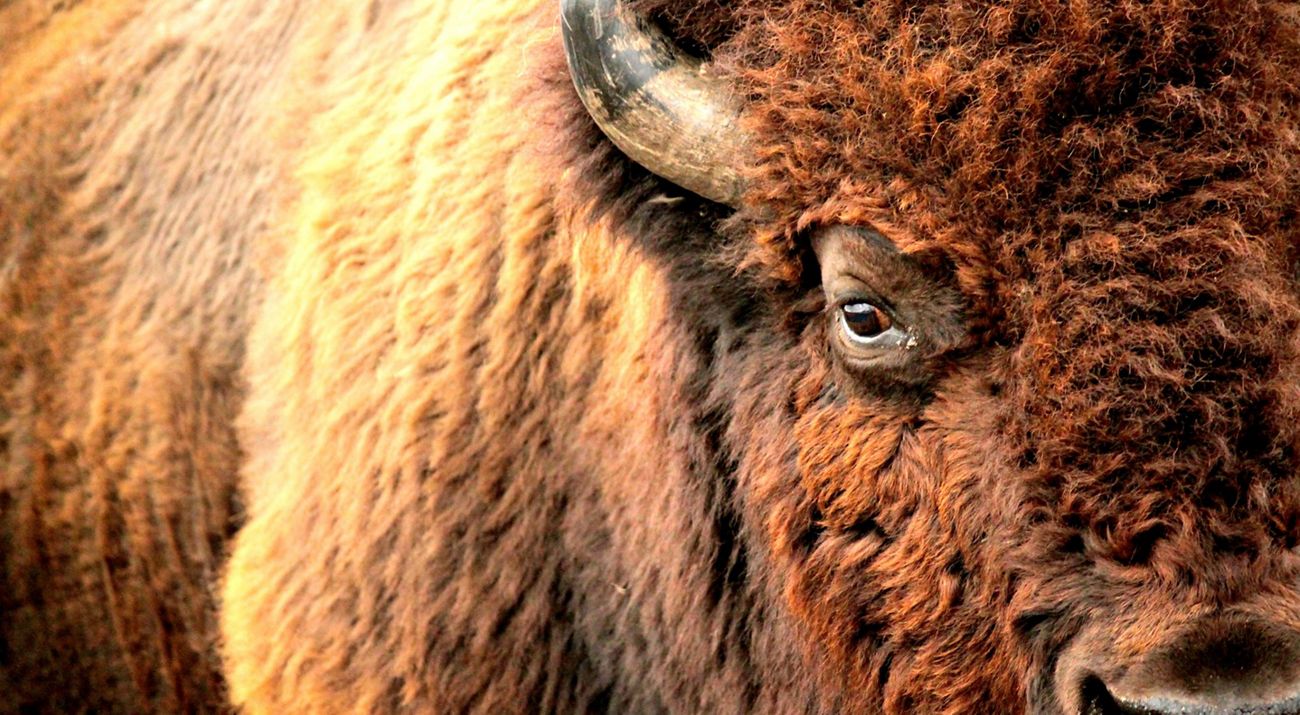
American Bison (Buffalo)
Learn about the iconic American bison and see what we’re doing to protect them.
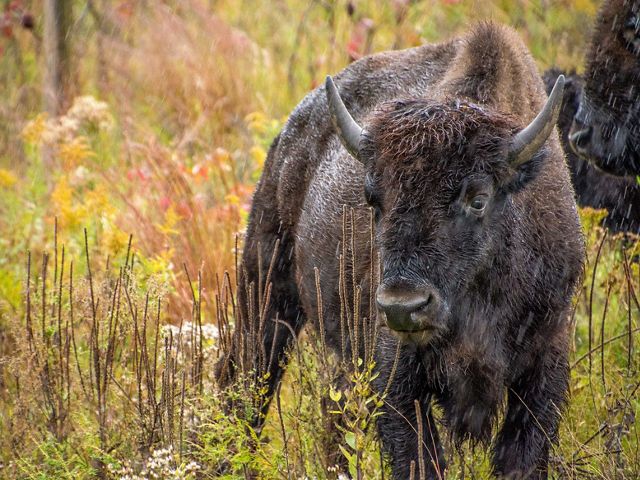
Facts About Bison
- Common name: American bison, buffalo
- Scientific name: Bison bison
- Conservation status: Near threatened, population stable
- Lifespan: 10 to 20 years
- Weight: Adult males: 1,000–2,200 lbs; Adult females: 790–1,200 lbs; Calf: 30-70 lbs at birth
Meet the American bison
The American bison takes the top prize for the largest land mammal in North America. Adult males weigh in at up to 2,000 pounds and stand as tall as six feet high at the shoulder.
These titans of North America are grazers, matriarchal-led family groups ranging from tens to thousands of buffalo. As they move across the prairie, they selectively focus on the grasses and sedges avoiding most of the forbs and legumes which helps balance the floristic competition. They sometimes wallow, which among many benefits helps mitigate biting insects and is also a social behavior thought to be a sign of contentment. These wallows create shallow depressions in the dense prairie which provide microhabitats to insects and amphibians among others to complete their reproductive cycles.


Bison Homecoming
Since 2020, we’ve transferred 1,000+ bison in TNC herds to their ancestral grazing lands.
Why this matters for Native NationsBison life cycle and reproduction
Male bison reach sexual maturity at 6 years old and females at 3 years old. They mate once each year from July up to September. During the mating season, also called the rut, bulls (males) will fight aggressively by ramming their heads together and charging at one another for a chance to mate with a cow (female).
After a nine-month gestation period, cows give birth to a single calf each spring. You can typically see mothers with young calves beginning in April.
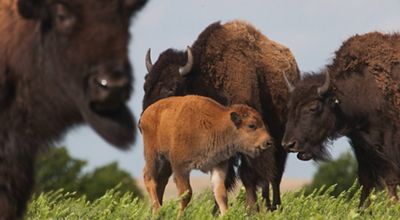
It’s worth noting here that female bison weigh up to 1,000 pounds and run just as fast as the males at 40 miles per hour.
Bison are very protective of their young and as a group do their best to protect them from any dangers. When visiting a TNC preserve—or any preserve—where bison are present, it’s best to give them the space and respect they deserve, for your safety and for theirs.
Wait… Are they bison or buffalo?
Yes! Both terms have important scientific and historical meanings and use, and both continue to be used today to refer to the official mammal of the United States. There are also hundreds of words from Indigenous languages that have been used for thousands of years. Words like: “tatanka” or “pte” in Lakota and “yanasi” in Cherokee.
Genetically speaking, the American bison is not akin to either the water buffalo of Asia or the Cape buffalo of Africa. The American bison are found only in North America and certain parts of Europe.


Oceans apart in their range, the physical appearance of the American bison is vastly different from water buffalo and Cape buffalo. Developing on different continents means they encountered different conditions including climate, which influenced the evolution of their bodies and behavior.
Protecting the American Bison
Millions of bison once lived and traveled across huge sections of North America. At one point, you could see these icons of the prairie from Canada all the way south to Mexico and even as far east and west as the coasts.
But as American settlers developed and expanded, the U.S. government encouraged settlers to slaughter millions of these animals, bringing bison and the Indigenous communities that relied upon the herds to near extinction in the early 20th century.
At the end of this brutality, tribal communities were decimated, and less than 1,000 free-roaming bison remained in the world.


Today, about 500,000 bison live in the U.S. and can be found in all 50 states. However, most of these bison are privately owned and raised as livestock. Only a small fraction of this number includes bison who are living in conservation herds and even much less than that are bison who are roaming on large landscapes. There are no truly free-roaming bison left in North America.
The Nature Conservancy collectively is one of the largest bison producers with over 6,000 bison living on 12 preserves we own and manage in the United States.

Why Bison?
How does TNC work with bison to manage grasslands in the Great Plains?
Bison can be found grazing on 12 of The Nature Conservancy’s preserves across North America. At TNC, we consider grazing to be essential to the health of our native prairies and grasslands. Recognizing that most of our grasslands in North America evolved under the influence of climate, fire and grazing, we reintroduced bison to our first preserve in 1978 and continue to support bison across our 12 preserves to ensure those lands remain diverse and resilient.
What does TNC bring to the table?
TNC has long been in the business of protecting our lands and waters. Across the Great Plains and beyond, we manage some of the highest-quality grasslands remaining in North America. It’s a little-known fact that native grasslands are one of the most endangered and least protected habitat types on Earth. Grasslands are also dependent on periodic disturbance, through grazing and fire to remain healthy and productive.
At TNC preserves, we manage bison herd sizes that support and enable healthy grasslands while also sustaining healthy bison. This careful balancing act ensures both bison and grasslands can thrive as conditions around us change. We also work with conservation partners like the National Park Service, Intertribal Buffalo Council, Tanka Fund, and other Indigenous organizations to transfer bison to support herds and communities around the country.
What do fragmented grasslands mean for bison?
Prior to colonial settlement in North America, bison roamed freely across North America, undeterred by obstacles commonly found today like the privatization of land, fences, diseases brought in by exotic cattle and other livestock not native to this land, roads and buildings. Since that time, a lot has changed and the native grasslands that once blanketed much of central North America have dwindled to just a small fraction of their former range.
What this means for bison is that they no longer have the physical space needed to live and sustain herd sizes of the past and coupled with their classification by many states as “livestock,” they cannot roam freely as wild animals as they once did.
How does returning bison to native grasslands affect the ecology of these landscapes?
The bison and grasslands of today are the result of a relationship that has evolved over the past 12,000 years. Bison help maintain grassland ecosystems in many ways. Bison provided the much-needed disturbance that healthy grasslands depend on, including their selective grazing, which created floristic balance and structure heterogeneity, nutrient recycling, wallowing, and many more. The relationship between fire and grazing is vital to creating a mosaic of habitats within the grassland ecosystem. Over thousands of years, this relationship aided in creating some of the most biologically diverse ecosystems on Earth.
Find a Bison Herd Near You
Visit one of these TNC preserves and watch the bison roam for yourself! Catch adorable cinnamon babies in spring or witness the thrill of the rut (from a distance) in fall.

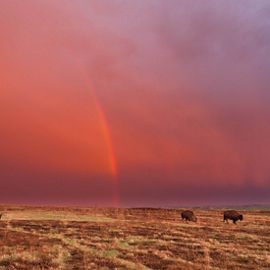
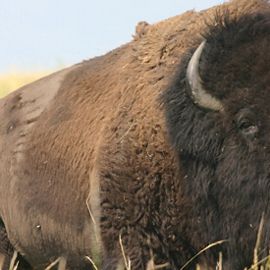
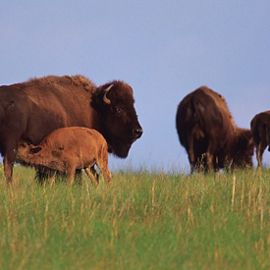
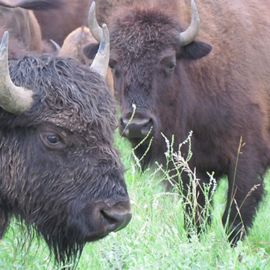
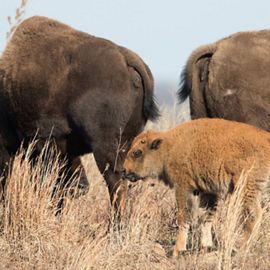
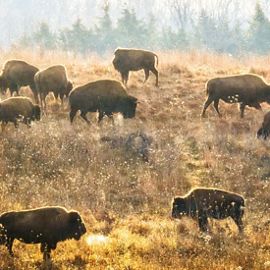

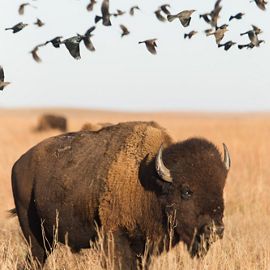
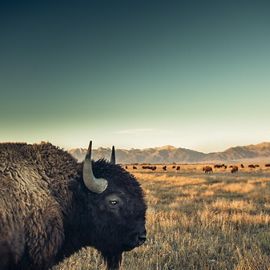
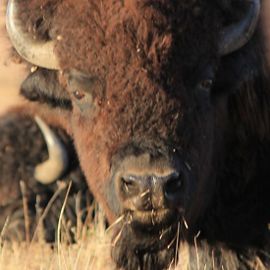

How Bison Help Grasslands Thrive
Bison have historically been important conservation practitioners on the grasslands they've roamed. Here are just a few of the ways bison help improve ecosystems in North America.
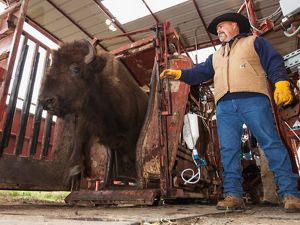
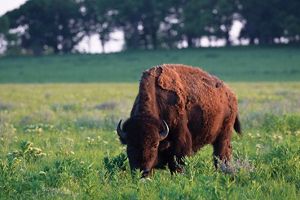

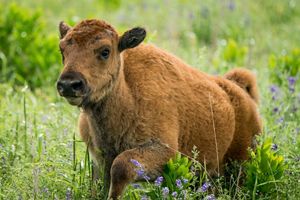
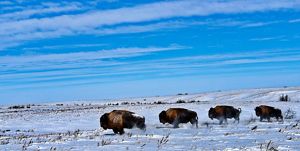
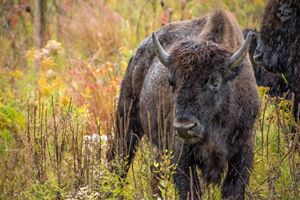
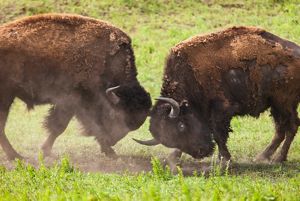

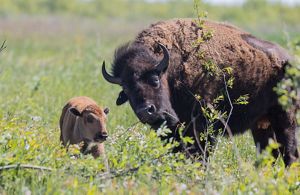
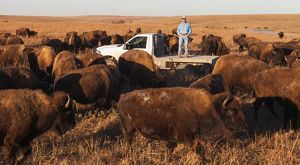

Bison Corral: Bison leap to freedom after being released from the final chute in the vaccination process. © Morgan Heim

Charismatic Megafauna: Furry, fierce and a force of the Great Plains grasslands, we are protecting North America's most iconic and charismatic megafauna. © David Smith

Bison in corral : Bison in dust and sunlight at the Niobrara Valley Preserve in Nebraska. © Amanda Hefner

Cinnamon Spring: A cinnamon colored bison calf trots through the blooming tallgrass prairie. © Larry W. Hall

Cross Ranch : Bison in the winter at Cross Ranch Preserve in North Dakota. © Lane Ketterman

Bison in the rain: Broken Kettle Grasslands Preserve, Iowa. © Chris Helzer/TNC

American bison: American bison roam and graze the spring grasses across the more than 40,000 acre Tallgrass Prairie Preserve in Pawhuska, Oklahoma. © Morgan Heim/TNC

Colorado Bison: Bison graze on the Colorado plains. © Dave Showalter

Bison-KSands-Quigley: Bison and calf at Kankakee Sands in Newton County, Indiana. © Michael Quigley

Save the Bison: Bob Hamilton, Tallgrass Prairie Preserve Director. © Morgan Heim
Support Bison and Grasslands Conservation
Grasslands are among the most endangered, yet the least protected, landscapes in the world. Give today to help TNC save grasslands and the bison that depend on them.


